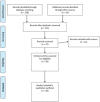The Relationship between Childhood Maltreatment and Non-Suicidal Self-Injury: A Systematic Review
- PMID: 28970807
- PMCID: PMC5609590
- DOI: 10.3389/fpsyt.2017.00149
The Relationship between Childhood Maltreatment and Non-Suicidal Self-Injury: A Systematic Review
Abstract
Introduction: Childhood maltreatment (CM) has been associated with an increased risk of non-suicidal self-injury (NSSI) and suicidal behaviors. However, the exact nature of the association between CM and NSSI is currently unclear. The present review aimed to systematically investigate the association between CM and NSSI in adolescence and early adulthood.
Methods: A systematic search of four major electronic databases covering both medical and social science research (PubMed, Scopus, Science Direct, and PsycINFO) was conducted.
Results: Overall, 20 cross-sectional studies including a total of 22,517 individuals, 3 longitudinal follow-up studies including 1,728 individuals, and 3 retrospective studies including 62,089 individuals were selected. It appears that CM is a significant risk factor for both NSSI and suicide attempts. The increased vulnerability to NSSI seems to be related to experiences of CM, particularly sexual abuse. Gender differences were also found. Generally, when compared to males, females who experienced CM seem to be more vulnerable to presenting with NSSI and suicidal behaviors.
Conclusion: There is a positive association between CM and NSSI. The importance of early detection and risk reduction of self-injurious behavior for adolescents is discussed.
Keywords: childhood maltreatment; emotional neglect; non-suicidal self-injury; physical/sexual abuse; suicidal behaviors.
Similar articles
-
Childhood maltreatment and non-suicidal self-injury in adolescent population: A systematic review and meta-analysis.Child Abuse Negl. 2024 Nov;157:107048. doi: 10.1016/j.chiabu.2024.107048. Epub 2024 Sep 26. Child Abuse Negl. 2024. PMID: 39332140
-
Suicide Probability in Adolescents With a History of Childhood Maltreatment: The Role of Non-Suicidal Self-Injury, Emotion Regulation Difficulties, and Forms of Self-Criticism.Int J High Risk Behav Addict. 2016 Jan 25;5(2):e23675. doi: 10.5812/ijhrba.23675. eCollection 2016 Jun. Int J High Risk Behav Addict. 2016. PMID: 27622166 Free PMC article.
-
Gender difference in the associations of childhood maltreatment and non-suicidal self-injury among adolescents with mood disorders.Front Psychiatry. 2023 May 25;14:1162450. doi: 10.3389/fpsyt.2023.1162450. eCollection 2023. Front Psychiatry. 2023. PMID: 37304441 Free PMC article.
-
Childhood maltreatment and non-suicidal self-injury: the mediating role of mentalization and depression.Eur J Psychotraumatol. 2025 Dec;16(1):2466279. doi: 10.1080/20008066.2025.2466279. Epub 2025 Feb 25. Eur J Psychotraumatol. 2025. PMID: 39995338 Free PMC article.
-
Childhood maltreatment and non-suicidal self-injury: a systematic review and meta-analysis.Lancet Psychiatry. 2018 Jan;5(1):51-64. doi: 10.1016/S2215-0366(17)30469-8. Epub 2017 Nov 28. Lancet Psychiatry. 2018. PMID: 29196062 Free PMC article.
Cited by
-
A Multi-Mediation Analysis of the Association between Adverse Childhood Experiences and Non-Suicidal Self-Injury among South African Adolescents.Int J Environ Res Public Health. 2024 Sep 17;21(9):1221. doi: 10.3390/ijerph21091221. Int J Environ Res Public Health. 2024. PMID: 39338104 Free PMC article.
-
Emotion-Related Network Reorganization Following Fish Oil Supplementation in Depressed Bipolar Offspring: An fMRI Graph-Based Connectome Analysis.J Affect Disord. 2021 Sep 1;292:319-327. doi: 10.1016/j.jad.2021.05.086. Epub 2021 Jun 5. J Affect Disord. 2021. PMID: 34139404 Free PMC article. Clinical Trial.
-
Childhood Maltreatment, Low Serum Cortisol Levels, and Non-Suicidal Self-Injury in Young Adults With Major Depressive Disorders.Front Pediatr. 2022 Jun 3;10:822046. doi: 10.3389/fped.2022.822046. eCollection 2022. Front Pediatr. 2022. PMID: 35722483 Free PMC article.
-
Childhood Trauma and Non-Suicidal Self-Injury Among Chinese Adolescents: The Chain-Mediated Role of Alexithymia and Rumination.Psychiatry Investig. 2024 Jul;21(7):726-735. doi: 10.30773/pi.2024.0041. Epub 2024 Jul 24. Psychiatry Investig. 2024. PMID: 39089698 Free PMC article.
-
Alterations of the endocannabinoid system in adolescents with non-suicidal self-injury as a function of childhood maltreatment.Transl Psychiatry. 2024 Dec 18;14(1):491. doi: 10.1038/s41398-024-03205-2. Transl Psychiatry. 2024. PMID: 39695136 Free PMC article.
References
-
- Martin J, Bureau JF, Cloutier P, Lafontaine MF. A comparison of invalidating family environment characteristics between university students engaging in self-injurious thoughts & actions and non-self-injuring university students. J Youth Adolesc (2011) 40:1477–88.10.1007/s10964-011-9643-9 - DOI - PubMed
Publication types
LinkOut - more resources
Full Text Sources
Other Literature Sources
Medical


